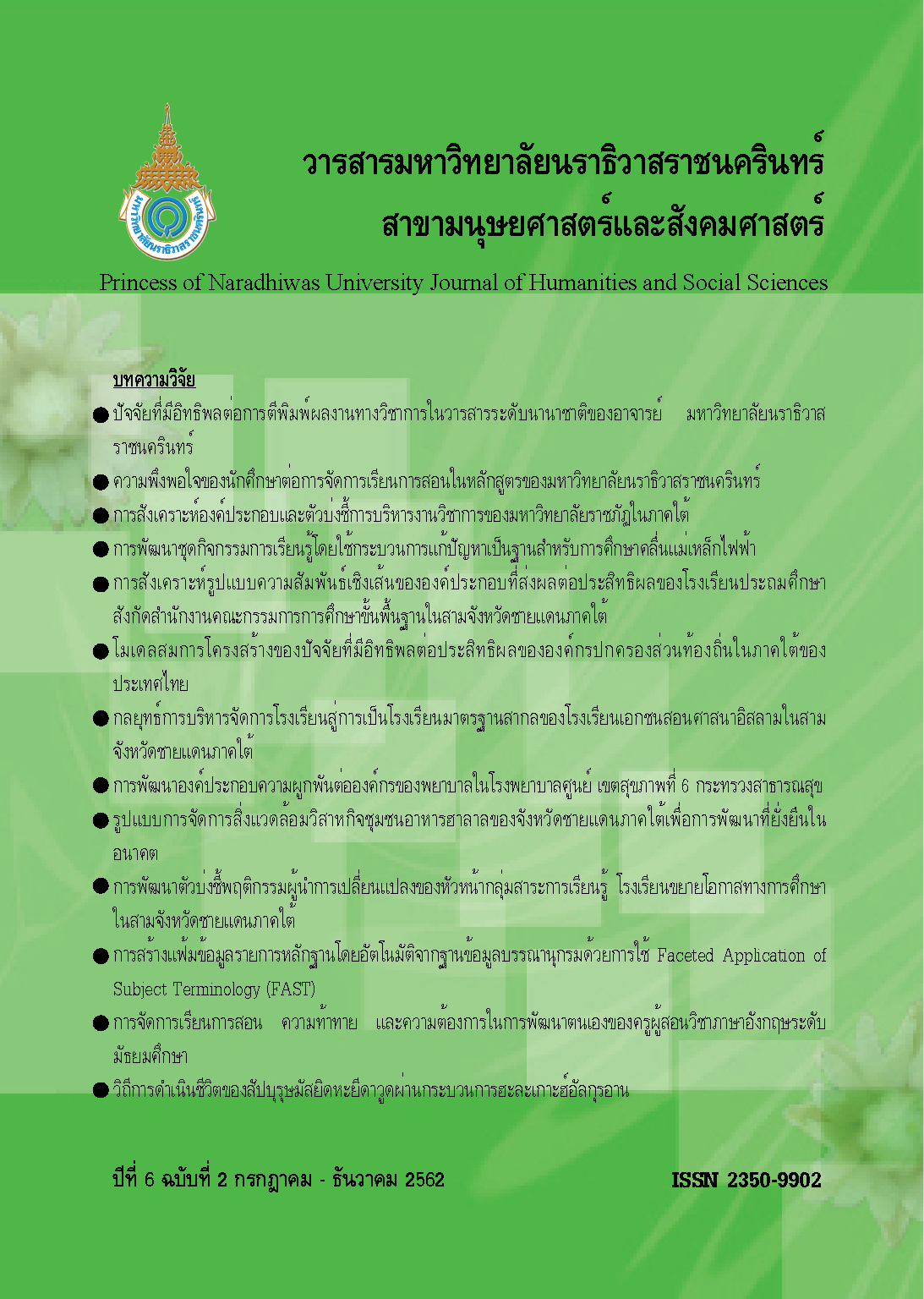โมเดลสมการโครงสร้างของปัจจัยที่มีอิทธิพลต่อประสิทธิผลขององค์กรปกครองส่วนท้องถิ่นในภาคใต้ของประเทศไทย
Main Article Content
บทคัดย่อ
การวิจัยครั้งนี้มีวัตถุประสงค์เพื่อ (1) ศึกษาโมเดลสมการโครงสร้างของปัจจัยที่มีอิทธิพลต่อประสิทธิผลขององค์กรปกครองส่วนท้องถิ่นในภาคใต้ของประเทศไทย(2) ตรวจสอบความสอดคล้องของโมเดลกับข้อมูลเชิงประจักษ์ใช้วิธีการวิจัยเชิงปริมาณ เก็บข้อมูลจากกลุ่มตัวอย่างที่เป็นพนักงานระดับหัวหน้างานและระดับปฏิบัติการในองค์กรปกครองส่วนท้องถิ่น จำนวน 216 คน ด้วยวิธีการสุ่มแบบแบ่งชั้นเครื่องมือที่ใช้ในการเก็บข้อมูลได้คือแบบสอบถาม ค่าความเชื่อมั่นอยู่ระหว่าง 0.850-0.930 สถิติที่ใช้ในการวิเคราะห์ คือ ค่าความถี่ ค่าร้อยละ และสมการโครงสร้างผลการวิจัยพบว่าผู้นำการเปลี่ยนแปลงไม่มีอิทธิพลทางตรงต่อประสิทธิผล ผู้นำการเปลี่ยนแปลงมีอิทธิพลทางตรงต่อการใช้อำนาจและวัฒนธรรมองค์การ การใช้อำนาจไม่มีอิทธิพลทางตรงต่อประสิทธิผล วัฒนธรรมองค์การมีอิทธิพลทางตรงต่อประสิทธิผลการตรวจสอบความสอดคล้องกลมกลืนของโมเดลกับข้อมูลเชิงประจักษ์ c2= 104.357, df =86, c2/df = 1.213, p-value = 0.087, GFI = 0.943, CFI = 0.996, RMR= 0.011 และ RMSEA = 0.032 ตามลำดับ พบว่า มีความสอดคล้องกับข้อมูลเชิงประจักษ์ ดังนั้น ผู้นำควรบริหารงานองค์การให้เหมาะสมกับการเปลี่ยนแปลง เพื่อให้เกิดประสิทธิผลและประสิทธิภาพต่อองค์การมากขึ้น
Article Details
References
กรมส่งเสริมการปกครองส่วนท้องถิ่น. (2560). ข้อมูลองค์ปกครองส่วนท้องถิ่น.เข้าถึงเมื่อวันที่ 9 สิงหาคม 2560 จาก http://www.dla.go.th/work/2559/LPA/index.jsp
กรรณิการ์ โพธิ์ลังกา และสุทธินันทน์ พรหมสุวรรณ. (2557). การศึกษาลักษณะส่วนบุคคล วัฒนธรรมองค์กรลักษณะสร้างสรรค์และสภาพแวดล้อมภายในองค์กรที่มีผลต่อประสิทธิผลการปฏิบัติงานของพนักงานระดับปฏิบัติการในย่านธุรกิจอโศก กรุงเทพมหานคร,วารสารวิทยาการจัดการ มหาวิทยาลัยราชภัฏเชียงราย,9(2), 91-113.
กัญญาณัฐ หนูรักษ์. (2556). พฤติกรรมภาวะผู้นำและการใช้อำนาจในการบริหารงานของหัวหน้าสถานีตำรวจภูธรในจังหวัดสงขลา : มุมมองนักปฏิบัติ. วิทยานิพนธ์บริหารธุรกิจมหาบัณฑิต, สาขาการจัดการธุรกิจ, บัณฑิตวิทยาลัย, มหาวิทยาลัยทักษิณ.
กัลยา วานิชย์บัญชา. (2550). การวิเคราะห์สถิติ: สถิติสำหรับการบริหารและวิจัย.พิมพ์ครั้งที่ 10. กรุงเทพมหานคร: จุฬาลงกรณ์มหาวิทยาลัย.
กิตติศักดิ์ แพรวพรายรัตน์. (2553). พฤติกรรมผู้นำของผู้บริหารในองค์กรปกครองส่วนท้องถิ่น อำเภอหนองแค จังหวัดสระบุรี (รายงานวิจัย). นครราชสีมา : มหาวิทยาลัยเทคโนโลยีสุรนารี.
ชยาธิศ กัญหา. (2550). ปัจจัยที่ส่งผลต่อประสิทธิผลของสำนักงานเขตพื้นที่การศึกษา สังกัดสำนักงานคณะกรรมการการศึกษาขั้นพื้นฐาน.ปริญญานิพนธ์การศึกษาดุษฎีบัณฑิต, การบริหารการศึกษา, บัณฑิตวิทยาลัย,มหาวิทยาลัยบูรพา.
ชลิดา ศรมณี, เดช อุณหะจิรังรักษ์, บุญเกียรติ การะเวกพันธุ์, จักรภพ ศรมณี, พีระพงศ์ ภักคีรี, วิโรจน์ ก่อสกุล และเฉลิมพล ศรีหงส์. (2555). การสร้างนวัตกรรมบริการสาธารณะโดยองค์การบริหารส่วนตำบล. กรุงเทพฯ: มหาวิทยาลัยรามคำแหง.
ชูตระกูล ไชยเสนา, ชูเกียรติ รอดวงษ์ และรัชดากร ทมินเหมย. (2560). ภาวะผู้นำการเปลี่ยนแปลงกับวัฒนธรรมองค์กรขององค์การบริหารส่วนจังหวัดสิงห์บุรี.วารสารมหาวิทยาลัยราชภัฏธนบุรี,11(1), 46-59.
ณัฐวุฒิ แก้วบางพูด. (2554). ความสัมพันธ์ระหว่างภาวะผู้นำการเปลี่ยนแปลงกับวัฒนธรรมองค์การกรณีศึกษา : เทศบาลนครภูเก็ต.วารสารวิทยบริการ มหาวิทยาลัยสงขลานครินทร์,22(1), 85-99.
ธงชัย สันติวงษ์และชัยยศ สันติวงษ์. (2542). พฤติกรรมบุคคลในองค์การ. พิมพ์ครั้งที่ 6. กรุงเทพฯ: ไทยวัฒนาพานิช.
ปริณ บุญฉลวย. (2556). วัฒนธรรมองค์การ องค์การเรียนรู้กับประสิทธิผลองค์การของศาลยุติธรรม ตัวแบบสมการโครงสร้าง.วารสารศิลปศาสตร์ มหาวิทยาลัยอุบลราชธานี,9(2), 181-229.
วีระศักดิ์ เครือเทพ. (2557). 9 กฎเหล็กสำหรับการบริหารจัดการที่ดีขององค์กรปกครองส่วนท้องถิ่น.วารสารสังคมศาสตร์,11(1), 5-12.
อุษณี มงคลพิทักษ์สุข. (2560). วัฒนธรรมองค์กรปกครองส่วนท้องถิ่นยุคไทยแลนด์ 4.0.วารสารร่มพฤกษ์ มหาวิทยาลัยเกริก,35(2), 141-162.
Aaker, D.A., Kumar, V., Day, G.S. (2001). Marketing Research. 7th ed. New York: John Wiley and Sons.
Bass, B.M., & Avolio, B.J. (1994). Improving Organization Effectiveness through Transformational Leadership. Thousand Oaks: Sage.
Bower, M. (1997). The Will to Manage. New York: McGraw-Hill.
Byrne, B.M. (2005). Factor analytic models: Viewing structure of an assessment instrument from three different perspectives.Journal of Personality Assessment.85, 17-32.
Chemers, M.M., & Ayman. R. (1985). Leadership Orientation as a Moderator of the Relationship between Job Performance and Job Satisfaction of Mexican Managers. Personality and Social Psychology Bulletin, 4,359-367.
Collins,J.C.(2001). Good to Great: Why some Companies Make the Leap and Others. New York: Random House Publisher Business Book.
Cooke, R. A., & Lafferty, J. C. (1994). Level V: Organizational Culture Inventory (Form III).Plymouth, MI: Human
Synergistics. Cooke, R. A., & Lafferty, J. C. (1983). Level V: Organizational Culture Inventory (Form I). Plymouth, MI: Human
French, J. & Raven. (1995). “The Base of Social Power” Group Dynamics. New York: Harper and Row.
Hair, Jr.J.F., Black, W.C., Babin, B.J., & Anderson, R.E. (2010). Multivariate data analysis: A global perspective. 7th ed. New York: Pearson Prentice Hall, Harper Collins College.
Joyce,W., Noria,N., & Robertson, B. (2003). What Really Works: The 4+2 Formula for Sustained Business Success. New York: Harper Collins.
Kimberly, J.K. (1979). Issues in Creation of Organization: Initiation, Innovation, and Institutionalization. Academy of Management Journal,22, 437-457.
Kline,R.B. (2011). Principle and Practice of Structural Equation Modeling. 3rd ed. New York: The Guilford Press.
Krejcie, R.V. & Morgan, D.W. (1970). Determining Sample Size for Research Activities. Educational and Psychological Measurement, 30(3), 607-610.
Livingston, J.S. (1971). Myth of the Well-educated Manager.Harvard Business Review, 79-96.
Northouse, P.G. (2001). Leadership: Theory and Practice. 2nd ed. Thousand Oaks, CA: SAGE Publication.
Ojo, A. (2015). Leadership and power: A study of the constructs of follower-perceived leadership style and leadership power, Journal of Behavioral Studies in Business,8(2), 1-14.
Robbins, S.P. (1990). Organization Theory: Structure, Design, and Applications. Englewood Cliffs, N.J.: Prentice-Hall.
Schumacher, R. E., and Lomax, R. G. (2010). A Beginners Guide to Structural Equation Modelling. 3rd ed. New York, NY: Taylor & Francis.

